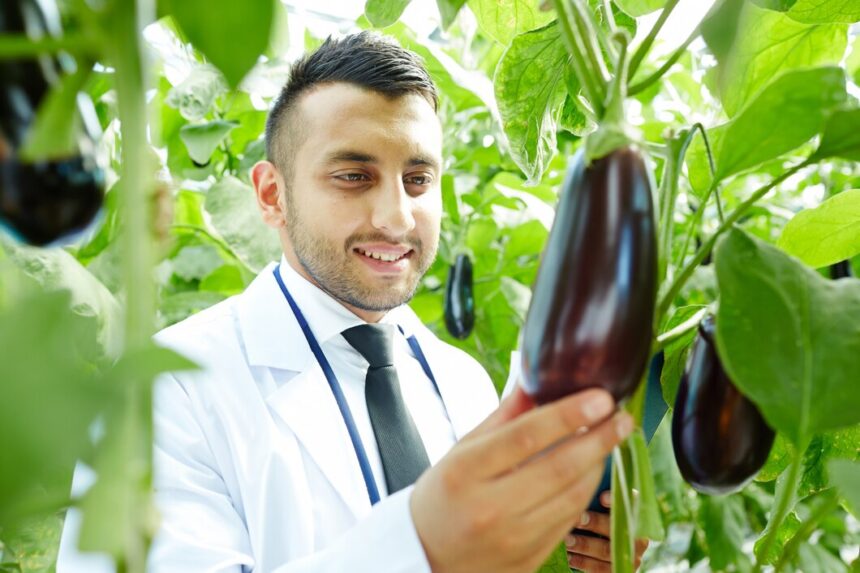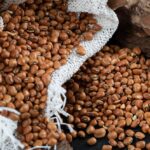Eggplants, also known as brinjals or aubergines, are a popular and versatile crop in South Africa. Growing them from seed to harvest requires careful planning, attention to detail, and proper management of inputs. This article outlines the entire process, including land preparation, planting, care during growth stages, pest management, and storage.
1. Land Preparation
Soil Type and Preparation
Eggplants thrive in well-drained, loamy soils rich in organic matter. They prefer slightly acidic to neutral pH levels (6.0 to 7.0). Before planting:
- Soil Testing: Conduct a soil test to determine nutrient levels and pH. This helps in making informed decisions about fertilizers.
- Tillage: Plow the soil to a depth of 30 cm to aerate and incorporate organic matter.
- Adding Organic Matter: Mix well-rotted manure or compost into the soil to enhance fertility and improve structure.
Machinery and Tools Required
- Plough and harrow for soil preparation
- Tiller for incorporating organic matter
- Soil testing kits or services
2. Sowing Seeds
Seed Selection
Choose high-quality seeds suited for the local climate. Varieties such as ‘Black Beauty’ and ‘Japanese Hybrid’ are popular for their flavor and yield.
Sowing Method
- Timing: Sow seeds indoors 8-10 weeks before the last frost or directly into the field when soil temperatures are consistently above 15°C.
- Seed Depth: Sow seeds about 1-2 cm deep in seed trays or directly into well-prepared seedbeds.
Inputs Required
- Seed trays or seedbeds
- Seedling soil mix or well-drained soil
- Watering can or irrigation system
3. Germination and Seedling Care
Germination Conditions
- Temperature: Maintain temperatures of 20-30°C for optimal germination.
- Light: Provide sufficient light to prevent leggy growth; grow lights may be necessary indoors.
Watering and Care
- Keep the soil consistently moist but not waterlogged. Water daily if needed, ensuring good drainage.
- Thin seedlings to prevent overcrowding, allowing stronger plants to develop.
Fertilizers
Use a balanced fertilizer (e.g., 10-10-10 NPK) to provide essential nutrients as seedlings grow.
4. Transplanting Seedlings
Timing
Transplant seedlings when they have 4-6 true leaves, typically 4-6 weeks after sowing, and when the risk of frost has passed.
Transplanting Process
- Spacing: Space plants 60-90 cm apart in rows that are 1 meter apart.
- Soil Preparation: Ensure the transplant site has been prepared with compost or well-rotted manure.
- Watering: Water thoroughly after transplanting to help settle the soil around the roots.
5. Growth Stages
Vegetative Growth
During the vegetative stage (2-4 weeks after transplanting):
- Monitor for pest issues (e.g., aphids, spider mites) and apply insecticidal soap if necessary.
- Fertilize with a high-nitrogen fertilizer to encourage leafy growth.
Flowering Stage
Eggplants begin to flower 6-8 weeks after transplanting.
- Pollination: Hand-pollination may be necessary in some cases.
- Watering: Increase watering frequency to support fruit development. Aim for 25-30 mm of water per week.
Fruit Development
Fruits typically start to set 2-3 weeks after flowering. Monitor plants closely during this stage:
- Fertilization: Switch to a high-potassium fertilizer to support fruit development.
- Watering: Maintain consistent moisture levels.
6. Pest and Disease Management
Common Pests
- Aphids: Use insecticidal soap or neem oil if infestations occur.
- Flea Beetles: Apply row covers or insecticides as needed.
- Whiteflies: Monitor and use sticky traps or insecticidal soap.
Diseases to Watch For
- Fungal Diseases: Look out for blight and powdery mildew. Use fungicides at the first sign of disease.
- Bacterial Wilt: Prevent this by practicing crop rotation and avoiding overhead watering.
Pesticide Use
Always follow label instructions and local regulations when using pesticides or herbicides. Apply them during cooler parts of the day to minimize harm to beneficial insects.
7. Harvesting
Eggplants are usually ready for harvest 70-90 days after transplanting. Look for:
- Color: Harvest when fruits are glossy and firm.
- Size: Depending on the variety, mature eggplants are typically 15-20 cm long.
- Picking: Use sharp scissors or pruners to cut the stem, leaving a small part attached to the fruit.
8. Storage
Post-Harvest Handling
- Handle fruits carefully to avoid bruising.
- Wash and dry eggplants before storage.
Storage Conditions
- Store in a cool, dry place with temperatures between 10-15°C and humidity levels around 90%.
- Avoid exposure to direct sunlight to prevent deterioration.
Growing eggplants from seed to harvest in South Africa can be a rewarding endeavor with the right knowledge and management practices. By following these steps, farmers can optimize their production, manage pests and diseases effectively, and ensure a successful harvest. With careful planning and attention to detail, eggplants can thrive, providing valuable yields and contributing to the local agricultural landscape.







